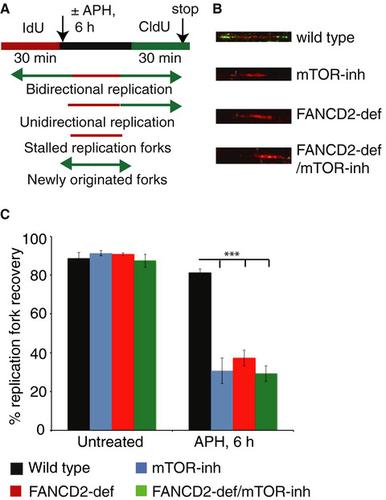当前位置:
X-MOL 学术
›
FEBS Lett.
›
论文详情
Our official English website, www.x-mol.net, welcomes your
feedback! (Note: you will need to create a separate account there.)
Fanconi anemia and mTOR pathways functionally interact during stalled replication fork recovery
FEBS Letters ( IF 3.0 ) Pub Date : 2021-01-28 , DOI: 10.1002/1873-3468.14035 Matthew Nolan 1 , Kenneth Knudson 1 , Marina K Holz 2 , Indrajit Chaudhury 1, 3
FEBS Letters ( IF 3.0 ) Pub Date : 2021-01-28 , DOI: 10.1002/1873-3468.14035 Matthew Nolan 1 , Kenneth Knudson 1 , Marina K Holz 2 , Indrajit Chaudhury 1, 3
Affiliation

|
We have previously demonstrated that Fanconi Anemia (FA) proteins work in concert with other FA and non-FA proteins to mediate stalled replication fork restart. Previous studies suggest a connection between the FA protein FANCD2 and the non-FA protein mechanistic target of rapamycin (mTOR). A recent study showed that mTOR is involved in actin-dependent DNA replication fork restart, suggesting possible roles in the FA DNA repair pathway. In this study, we demonstrate that during replication stress mTOR interacts and cooperates with FANCD2 to provide cellular stability, mediate stalled replication fork restart and prevent nucleolytic degradation of the nascent DNA strands. Taken together, this study unravels a novel functional cross-talk between two important mechanisms: mTOR and FA DNA repair pathways that ensure genomic stability.
中文翻译:

范可尼贫血和 mTOR 通路在停滞的复制叉恢复过程中功能相互作用
我们之前已经证明范可尼贫血 (FA) 蛋白与其他 FA 和非 FA 蛋白协同作用,介导停滞的复制叉重新启动。先前的研究表明 FA 蛋白 FANCD2 与雷帕霉素的非 FA 蛋白机制靶点 (mTOR) 之间存在联系。最近的一项研究表明,mTOR 参与肌动蛋白依赖性 DNA 复制叉重启,这表明 mTOR 在 FA DNA 修复途径中可能发挥作用。在这项研究中,我们证明在复制应激过程中,mTOR 与 FANCD2 相互作用并协同提供细胞稳定性,介导停滞的复制叉重新启动并防止新生 DNA 链的溶核降解。总而言之,这项研究揭示了两种重要机制之间的一种新颖的功能串扰:确保基因组稳定性的 mTOR 和 FA DNA 修复途径。
更新日期:2021-01-28
中文翻译:

范可尼贫血和 mTOR 通路在停滞的复制叉恢复过程中功能相互作用
我们之前已经证明范可尼贫血 (FA) 蛋白与其他 FA 和非 FA 蛋白协同作用,介导停滞的复制叉重新启动。先前的研究表明 FA 蛋白 FANCD2 与雷帕霉素的非 FA 蛋白机制靶点 (mTOR) 之间存在联系。最近的一项研究表明,mTOR 参与肌动蛋白依赖性 DNA 复制叉重启,这表明 mTOR 在 FA DNA 修复途径中可能发挥作用。在这项研究中,我们证明在复制应激过程中,mTOR 与 FANCD2 相互作用并协同提供细胞稳定性,介导停滞的复制叉重新启动并防止新生 DNA 链的溶核降解。总而言之,这项研究揭示了两种重要机制之间的一种新颖的功能串扰:确保基因组稳定性的 mTOR 和 FA DNA 修复途径。











































 京公网安备 11010802027423号
京公网安备 11010802027423号